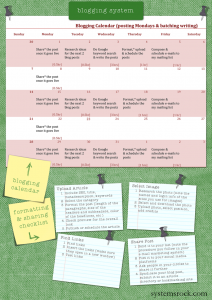In the previous example, we looked at a written testimonial system. Today, let’s create a structure for your blog writing.
You know the benefits of blogging.
Blogging generates leads and sales conversions by increasing traffic to your site, enhancing the perception of your expertise, and making your offerings more visible.
But…
Blogging on a regular basis is very challenging, especially as we get busier.
How many times have you found yourself panicking because a blog post was due and you didn’t have anything ready?
Have you broken your commitment to regular blogging because you just can’t find time to write or are tired of stressing out about coming up with ideas for blog posts?
I’ve got some good news for you.
 There’s a way to make your ideas flow and get your blog posts completed on schedule.
There’s a way to make your ideas flow and get your blog posts completed on schedule.
Take a look this sample blogging calendar (Click on the image on the left-hand side to enlarge it):
What steps of the process are the same for you? Where do you take a different approach?
Take a moment to reflect on your blogging process.
Is there a specific part of the process of creating a blogging structure that stresses you out the most?
- If it’s writing blog posts at the very last minute, be more intentional about allowing yourself more lead-time. I know it’s easy to skip blog writing item on your to-do list in favor of a client project. But look at it this way—your blog post could get you your next client. Wouldn’t that make it worth sticking with your calendar?
- If you are struggling to get into “writing mode,” notice if there are any specific situations that put you into the mode when blog posts are flowing out of you—after a walk, work out, morning meditation… Experiment with different routines or triggers to turn blog writing into a habit. Also, try batching—writing or re-purposing several posts at once.
- If you dread uploading and formatting the posts, create a checklist using the above example and have someone else do it for you. Hate checklists? Record your screen as you upload the post narrating the steps. Share the video with your assistant, have them create the step-by-step, and test it to make sure that no step was forgotten.
- If you are tired of writing the same old blog posts, take a look at the below ideas for creating valuable and engaging content:
1. Share Your Clients’ Success Stories
Case studies are a simple, extremely powerful way of sharing content.
All you need to do is ask your successful clients if they’d be willing to share their transformations. Then you can just create an intro and a conclusion to frame their story. That’s it! It’s done.
To make it easy for your clients to share their stories, ask them questions like:
- What were you struggling with before you worked with me?
- How did that struggle weigh you down and hold your business back?
- What has changed as we’ve worked together?
- How are you feeling now that your struggles are solved?
What’s so great about this strategy is that is flatters your client in an authentic way and celebrates their suggest, demonstrates the results you get clients, and helps prospective clients get a sneak peek into what it’s like to work with you.
Bonus points. Those can be the very questions you use in the feedback form you ask your clients to fill out once they finish working with you. Your clients’ responses can be used for both testimonials and case studies.
2. Interview Industry Leaders
Create a series of questions you know your audience would love answered.
Send one or more of these questions to industry leaders you admire and see if they’re willing to share their wisdom in 2-3 sentences. (Don’t forget to include a note of appreciation and tell them you’ll include a link to their websites!)
After collecting the replies, all you’ll need to do is create a few opening sentences describing the questions you asked and why you asked these leaders. Then share them with your readers!
This technique makes it super simple to generate content your audience is eager to read and it generates more traffic to your site due to the popularity of the industry leaders.
3. Curate Existing Content
You don’t have to constantly create original content.
Capitalize on the wonders of content curation, which involves collecting, analyzing and presenting existing content.
As an expert in your area, you’re consistently monitoring and examining the most relevant news sources to stay abreast of developments within your industry.
When you come across something thought provoking or controversial, share it with your audience by framing it within your own perspective and quoting from it.
This method works especially well with new books, studies or findings.
Do you feel inspired to create content for your blog or newsletters?
Does creating a blogging structure seem in your reach now? 🙂
Back to You
What can you do this week to streamline your process of blog development and posting?



I always worried about writing about the exact same topic, maybe from a slightly different angle, to closely together! Then, I figured out a way to turn them into a monthly theme discussion to keep readers moving along the same way, and I get to write a month’s worth of posts in one day. =D
Very smart, Grace! 🙂
Great article, Natasha! By the way, great name (it’s also my middle name). 🙂
Sometimes, we (and by we, I mean me) have a tendency to overthink and overcomplicate the matter of blogging, by weighing myself down with too many ideas and too many possibilities. So, it’s really helpful for me to keep things simple and focused.
Your chart is great – it lists out the basics, plus a few extras, but doesn’t overwhelm me with too many to dos. Thanks much! I pinned it. 🙂
Great to meet you, Abi Natasha :). I agree, it’s super easy to get carried away and, as a result, overwhelmed. Happy to hear that you’ve found the chart useful! And thank you for pinning it!
Thanks for this! I love your calendar. I have been stuck lately and really need to schedule blogging. I am not sure about some of the details in your calendar such as the Google keyword search and hoe to syndicate the post. Perhaps you have already discussed this?
Thanks!
Sue.
Sure, Sue! Re: Google keyword search, Natalie Lussier wrote a really great post for me a while back: http://systemsrock.com/the-10-minute-seo-routine-that-will-have-search-engines-ranking-you/.
As for blog post syndication, take a look at the Syndication part of this infographic: http://www.launchgrowjoy.com/30-ways-to-promote-your-blog-posts/. Hope this helps 🙂